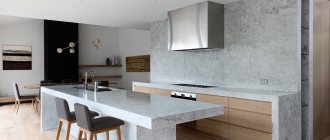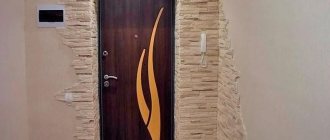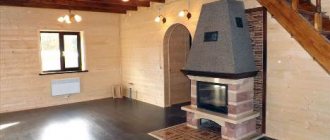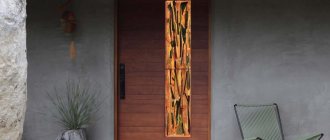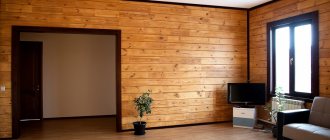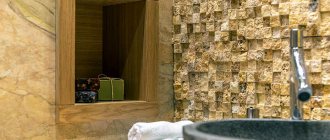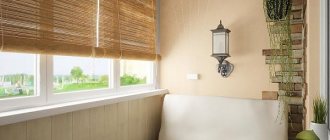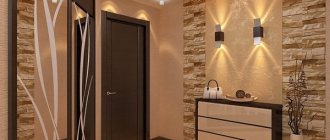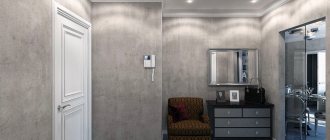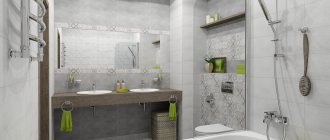Advantages of using decorative stone
This method owes its popularity to the presence of a number of advantages, such as:
- Affordable price.
- Large selection of models.
- Beautiful interior style.
- Combines perfectly with other finishing materials.
- Does not require preliminary preparation of the wall.
- The surface of the material is resistant to moisture.
In addition to all these features, it is quite difficult to damage such a coating - the structure of the stone is strong and resistant to mechanical stress.
4.Primer of walls
When the putty has dried completely and completely, you can prime the surface. Before this, minor roughness on the walls should be eliminated by treating the surface with fine sandpaper. After all the dust has been removed from the corridor, you can coat the walls with two layers of primer. It is better to purchase an acrylic primer.
In the event that only fragmentary cladding is being done, then the allowance left on the wallpaper should also be primed. This work must be done properly; if the wall is poorly primed, the stones may subsequently fall off.
At this point, the pre-preparation process ends, and you can begin laying the facing material directly.
Features of interior decoration
The choice of decorative coating is not the only issue that the master needs to decide before starting work.
Before decorating the walls with stone in the hallway, it is worth calculating the square footage of the room, the required amount of stone and auxiliary building materials.
When working with expensive and complex relief types of stone, it is worth getting specialist advice or using the services of a professional interior finishing specialist.
The steps to decorate the hallway include the following steps:
- Preparation of material and tools.
- Dismantling the old covering.
- Alignment of walls.
- Surface priming.
- Laying stone.
Decorating the hallway walls with decorative stone is an activity that requires clarity and a strict procedure. By performing all actions strictly according to the scheme, you can achieve an excellent result without disturbing the overall style of the interior in the hallway.
Decorative bricks, application possibilities
Decorative bricks offered by manufacturers are often used in hallways, because such material is easy to use for wall decoration.
Light and practical finishing allows you to fully support the illusion of stylish brickwork, for the arrangement of which bricks of different colors and structures were used.
Preparation of material and tools
When purchasing decorative stone, you should immediately stock up on the following tools that will be needed when carrying out repair work:
- Hacksaw or grinder (depending on what type of stone will be used).
- A set of spatulas of various sizes and shapes.
- Construction level to control the even laying of the coating.
- File for grinding parts of stone.
- Varnish and paint brushes (acrylic varnish will create a glossy shine and an additional protective layer on the surface of the coating).
- Primer for walls.
- Glue (it is better to choose gypsum or cement based types).
Auxiliary tools such as a pencil and a ruler for marking stone parts can be prepared as you go.
12.Finish
The final touch in the work of covering the surface of the hallway walls with stone is the finishing of the stones with a special varnish. As a rule, high-quality acrylic-based varnishes look ideal. In those places where the coating is usually subject to constant contact, three layers of varnish must be applied. Walls that are varnished usually last much longer and look better. To apply varnish, you can take an airbrush or spray gun.
In addition to the traditional steps listed above, you can also use additional decoration of the masonry when decorating the hallway with decorative stone . Usually, it is not always possible to match the intended color scheme of different finishing materials used in the same room. To achieve harmony, the stone can be tinted on top, or the texture can be emphasized with gold or silver paint, if this suits the style. With the help of proper use of dyes, it is easy to achieve a very original three-dimensional effect.
The finishing touch is also to process the masonry at an angle using an airbrush. This is done with a mixture of pigment, water and regular acrylic varnish. This way you can not only give the desired color scheme to the masonry, but also repair unsightly seams. For strong spraying, you should prefer a shade darker than the color of the stone.
In order for your masonry to look beautiful and impressive, you need to correctly arrange local lighting sources. As a rule, decorative stone looks good in dim lighting. Several small sconces with yellow light will give the whole room warmth and comfort, cold white light will add fundamentality and rigor - in principle, it all depends on the chosen style.
Decorating the hallway with decorative stone goes well with a wide variety of materials: it can be not only wood, but also glass and even steel. That is why designers are increasingly using this material in high-tech, or in the style of modern minimalism. It should be noted that if you decide to clad the walls with dark-colored stone, it is better to make the other finishing lighter, otherwise the corridor will seem gloomy.
Finishing with decorative stone is perhaps the best, most practical and effective option for renovation in any hallway. With the help of decorative stone you can give a certain mood to the room, make the entire interior not just cozy and representative, but also truly luxurious. Decorative stone can be combined with plaster and wallpaper, as well as with simply painted walls. Therefore, when starting work, do not forget the old and tired, but true truth: a house begins with a hallway, like a theater with a coat rack.
Preliminary leveling of walls
This procedure is necessary so that the decorative stone fits better and more evenly on the underlying base.
All minor defects (small cracks, gaps) are covered with a layer of putty. Larger irregularities or construction defects are plastered.
Particular attention should be paid to surfaces near door jambs - this is where deep cracks most often form over time.
What part of the wall should be finished with stone?
There are always places in the hallway that the owner of an apartment or house will accidentally touch with dirty shoes, or against which a bicycle or travel bag will be leaning. We will use this part of the wall to decorate the hallway with stone. Everything else can be light and cheerful.
But the problem area is reliably protected by stone. Due to the wide range of prices for decorative designs imitating stone or natural building materials, it is quite simple to make such decorations for the entrance area.
It is best to use only a small, most contaminated section of the wall. The effect is amazing - absolutely all street markers disappear. The room will expand visually. And glossy suspended ceilings will only help expand the room.
If your house is created in the same style, then it is easy to decorate the entrance room in the desired style. The main thing is to approach the choice of finishes creatively. Remember your favorite places. Where you once managed to visit, look through old photographs, create an interesting room design from memory.
A little nostalgia - and in front of you are the miracles you once saw. Decorative stone or even custom-made photo wallpaper will help - it’s up to you. It’s not at all necessary to cover the entire entrance room with stone; such tiny rooms look difficult.
Priming the walls
The next step is to apply 1-2 layers of primer to the surface of the walls. This must be done for a number of reasons:
- Preliminary priming of the surface allows you to get rid of dust and dirt.
- In this way, additional stickiness of the underlying layer is created.
- The primer protects the walls from the possible development of fungal colonies.
Thus, this procedure can significantly increase the service life of the decorative coating.
- Window sill on the balcony - 165 photos of modern ideas and options for using window sills
Tile in the hallway: stylish, beautiful and creative tile options (video + 170 photos)
Kitchen backsplash tiles - design ideas and the best examples of using tiles (165 photos + video)
2. Dismantling the coating
Preparing the walls for finishing the hallway with decorative stone usually begins with the complete removal of old coatings from the surface. Outdated wallpaper, peeling paint, and even more so, old tiles must be completely removed. The plaster can be left only if it adheres perfectly to the wall along the entire perimeter. If it crumbles, at least in several places, it is better to get rid of it by stripping the walls down to bare brickwork, wooden beams, or concrete surfaces.
If the project involves only partial application of stones, then the previous coating can be removed only where decoration is provided for according to the sketch, making an allowance of about two centimeters. When finishing is carried out in individual areas, the old coating should be removed with the utmost care. First, you need to mark the edges of the treatment on the wallpaper with a pencil. The wallpaper is carefully cut out using a stationery knife to avoid damaging it. The edge of the plaster or other hard layer can be trimmed with a grinder. If there is any glue left from old wallpaper, it needs to be soaked with water and then removed with a spatula. At the end of the cleaning, the walls are thoroughly washed several times.
Laying decorative stone
To create a more natural and original pattern, it is better to lay the covering elements in different directions so that adjacent seams do not have the same course. Sequence of finishing work:
- Diluting the glue (the method will depend on the type of glue and its base). It is better to prepare the working solution strictly according to the instructions, and then the glue will hold the decorative stone more firmly.
- First row location. It is customary to start work from the corner of the wall (top or bottom - it doesn’t matter).
- A layer of glue is applied to each fragment using a notched trowel.
- The stone element is pressed against the wall surface, aligned in the direction of the seam and excess glue is removed.
For ease of work, you can use a ready-made diagram for laying decorative stone. You should also familiarize yourself with the various options for finishing the hallway with stone, which will help you understand the progress of laying the covering elements.
Design ideas with artificial stone in the hall
For the design of a corridor with decorative stone, there is a wide selection of different materials. They imitate natural rocks with great reliability, and in addition, they have other, more original textures and colors.
Stone-effect tiles were used to cover the floor in the hall. Source: britishceramictile.com
Decor with plaster stone
An analogue of stone, created on the basis of gypsum, is an extremely popular solution for finishing walls in the hallway. It is environmentally friendly in its composition and can reproduce in a variety of forms. Most often it is an imitation of bricks, slate, wild torn stone and even cobblestone.
Gypsum stone tiles decorate the hallway wall with a fresco. Source: smalldesignideas.com
Decorative stone made of gypsum is very light and easy to install; it is glued to the walls. Gypsum tiles are used to decorate doorways, partitions, corners and niches of the corridor.
Fragmentary stone trim in the hallway. Source: womanadvice.ru
The weakness of gypsum stone is its instability to moisture. But in the design of the corridor this will not be a defining feature. And the texture and variety of variations of such material provide a lot of creative possibilities: they can be used to highlight mirrors, wall sconces, shelves and columns.
Such solutions are especially good for the design of long and narrow hallways, where local stone finishing is appropriate.
The illuminated niches in the hallway are decorated with decorative stone. Source: womanadvice.ru
Another advantage of gypsum stone is its low price, which makes it much more affordable than natural stone.
Porcelain tiles in the hallway
There are so many types of porcelain stoneware that it will not be difficult to choose an imitation of any stone covering: marble, granite, slate, travertine or dolomite. Unlike natural stone, porcelain tiles are also available in non-traditional formats, for example, in the form of popular hexagons.
Porcelain tiles on the hallway floor are combined with boards. Source: smalldesignideas.com
The composition of porcelain tiles is natural (its base is clay), and its strength is very high, and porcelain tiles can even be laid on a warm floor. This is very important in the hallway, where sometimes you need to dry your shoes or get rid of moisture from the street.
Practical porcelain stoneware floor in a bright hallway. Source: realhomes.com
When choosing porcelain stoneware for decorating a corridor to look like stone, it is important to choose the right color. A floor that is too light or, conversely, black will be too easily soiled. Brown, gray and beige tones will relieve owners from cleaning problems.
Chocolate-colored porcelain tiles on the floor of the hall with stairs. Source: karndean.com
Porcelain tiles are a more impressive and high-quality material than ceramic tiles. But it is much more economical than natural stone, while being wear-resistant and visually attractive.
Porcelain tiles are used in any hallway interior style, from classic to country and minimalism.
Suitable here
×
Design table lamp Incubate 3101/T
13990 rub.
buy
Porcelain tiles with imitation marble in a classic hallway. Source: impressiveinteriordesign.com
Brick corridor design
Brick and clinker tiles are one of the popular ways to decorate a hallway with a stone look. Depending on the color and style of such decorative stone, it will fit into both traditional and modern interiors.
Brick wall in loft style in the hallway. Source: smalldesignideas.com
Brickwork in the hallway can cover the walls completely or be placed zonally if there is a risk of overloading the room. Brick painted in light colors or a combination of several similar shades looks interesting.
Classic brickwork in a modern hallway is complemented by mirrors
The stone design of the hall is complemented by wooden or porcelain stoneware floors, metal accessories, and mirrors. Interiors in loft and modern styles are decorated with colored posters, clocks or panels - against the backdrop of brick walls they look especially decorative.
Types of decorative stone for the hallway
On the building materials market you can find a fairly rich selection of materials: natural and artificial options.
More preference is given to artificial materials, since natural stone has a high cost and requires the help of a specialist to carry out repairs.
Advantages of artificial material
Before you make your choice, you should find out all the advantages of finishing with artificial stone:
- Relatively low price.
- Light weight, which reduces the load on wall supports.
- There are no special care or cleaning requirements.
- Does not fade under the influence of sunlight.
- Wide selection of models in color, texture and shape.
This type of decorative stone has earned particular popularity among apartment owners and interior decorators due to the ease of repair work.
- Hanger in the hallway: 185 photos of modern ideas for the design and use of hangers
- Paintings for the living room: beautiful and modern trends in the placement of paintings (135 photos and videos)
- Carpet for the living room - 165 photos and videos of expert advice on choosing and using carpets and coverings
About the advantages and disadvantages
The advantages of finishing include:
- harmony with any style;
- a huge range of textures, shapes and colors;
- originality;
- easy maintenance and long service life;
- decorating walls in this way will not be difficult;
- the stone is not susceptible to infection by fungal growths;
- environmental friendliness;
- light weight.
Cons of artificial stone:
- shorter service life compared to natural materials;
- some samples made of soft material quickly take on a shabby appearance;
If you correctly select this decorative element, then the listed shortcomings will remain in the shadows. To protect it from negative environmental influences, its surface is treated with a special impregnation or varnished.
Cement-based decorative stone
This coating option is particularly durable and resistant to moisture. The surface of walls finished with cement stone is easy to clean without fear of residual contamination. For finishing the hallway, cement elements will be an excellent solution.
In addition, the stores offer the buyer a huge assortment of design ideas.
But when choosing this material, it is worth remembering the negative aspects of stone: heavy weight, difficulties when cutting and polishing building blocks. Before laying the covering, additional strengthening of the walls is required.
9.Corner lining
It must be said that corners, both external and internal, usually receive various mechanical damage the most. For this reason, very often in the hallway the corners are laid out in fragments with decorative stone. This will not only thoroughly protect your walls, but will also be an original decoration of the entire interior. It is better to place large parts of decorative finishing only up to the middle of the wall, otherwise there will be a visual “pressing” effect.
Before you start finishing with decorative stone , you need to purchase corner tiles, among other materials. Although they, as a rule, are somewhat more expensive, their presence will significantly simplify the entire process of further cladding. If for one reason or another this is not possible, then the tiles can be given the required shape using a hacksaw if the stone is gypsum, or a grinder if the stone is concrete. There are two generally accepted methods for laying corners:
- The laying fragments are simply installed overlapping. To ensure that the ends are not noticeable at the outer corners, they can be slightly filed with a file and carefully tinted. For an internal corner, as a rule, such processing is not necessary.
- All edges of decorative stones are ground at an angle (45°). This option is typically used for gypsum products that are simply processed.
It is necessary to closely monitor the normal alignment of all joints. Glue is applied to the previously prepared stones, then they are placed on both sides of the corner and pressed very tightly against the wall surface. After completing the formation of the corner, you can then continue laying the horizontal rows of the entire cladding according to plan.
Decorative sandstone stone
This model is classified as a flexible type of stone. For finishing, you can cut a very thin layer of material, which is quite easy to lay on the wall.
With the help of sand stone, it is possible to create a pleasant interior with natural shades and beautiful patterns. The only drawback is that the layers of stone should only be glued onto the underlying textile base.
Stone and brickwork
Under the stone
It has many varieties, including cladding, installing stones on a flat surface with an adhesive mixture.
A flat view of the kitchen wall is laid with a die, and it is necessary to select and lay it so that there are no obvious voids. Volumetric masonry made of thin stone can be laid smoothly or in relief.
Under the brick
Stone in the kitchen can be laid using American, English, or Flemish bonding.
In the photo, the wall in the work area is lined with granite and highlighted with a niche made of brickwork to resemble a rustic stove.
The “Castle” cladding imitates the masonry of a medieval fortification. A rectangular identical stone is laid according to the “Shahriar” type.
The photo shows brickwork in a modern-style kitchen, where brick performs not only a decorative, but also a practical function.
Stone in the form of clinker tiles
Such decorative coating models are made from certain types of clay. The creation technology involves firing finishing elements in a kiln to form a natural relief pattern.
The thickness of each stone does not exceed 2.5-3.0 cm, which greatly simplifies the process of working with this model.
Decorative stone made of gypsum
This model has a number of advantages that determine the popularity of the material:
- Low cost.
- Light weight material.
- Ease of practical application.
Unfortunately, there were some drawbacks:
- The coating does not tolerate high indoor humidity.
- After laying the stone, 2-3 layers of acrylic varnish must be applied to the surface.
The choice of artificial stone depends on the preferences of the apartment owner, his financial capabilities and the characteristics of the hallway room.
Types of natural stone
Marble
It is distinguished by colored veins and is not resistant to kitchen cleaning chemicals. It is better to cover a marble apron or a wall near the sink with a protective layer.
Granite
Granite is equally durable and comes in different shades depending on the place of origin. Tolerates high temperature, moisture, shock.
Travertine
It withstands mechanical stress well, but does not tolerate contact with chemical acidic kitchen cleaning products. Usually gray or white.
Dolomite
It comes in white to brown color, it is used to line stoves, it is heat resistant, and its parameters are similar to granite.
Slate
It comes in yellow, brown, burgundy, green and multi-colored varieties. Thin thickness and smooth surface is suitable for layering.
The photo shows a slate wall in a modern kitchen, which is easy to clean and has a high service life guarantee.
Sandstone
It is a porous rock, its hardness depends on the bonding limestone or quartzite. Used for wall cladding.
Onyx
Shimmers in light and dark layers. Durable, decoratively attractive for wall decoration in the kitchen.
Pebbles
River or rock pebbles of different colors require cleaning to prevent mold from appearing in the spaces between the stones, if this is a kitchen surface with high humidity, or an apron.
The photo shows a black pebble work surface, which is evenly sunk into cement and sanded to a smooth surface for easy cleaning.
Hallway finishing combinations
In practice, hallways are decorated not only with stone, but also with other materials in combination with decorative stone.
For example, decorating a hallway with stone and wallpaper is a very stylish option that allows you to combine two different design trends.
For those who have not yet decided on the choice of design style and material, there are catalogs with photos of ready-made options for finishing the hallway with stone.
Wall in the kitchen
Choosing stone to decorate kitchen walls is a bold, original decision. Unusual texture, warm colors, combination with other materials and an endless number of design options will create a cozy atmosphere conducive to eating and leisurely conversation.
With it you can:
- completely cover all walls;
- finish one wall;
- make inclusions.
This type of finishing can visually solve problems with room space. With a horizontal arrangement of masonry, lighter colors and the addition of contrasting details, a small kitchen will visually increase in size. A spacious dining room will be reduced in size and become more comfortable if dark colors are chosen to decorate its walls and spotlights or sconces are used.
Advice A stone, whether natural or artificial, does not tolerate bright light. Only soft, subdued lighting can fully convey the beauty of the finish. Direct sunlight negatively affects the quality of some finishing materials.
The cladding is easy and quick to install. This makes it attractive for covering large surfaces and adding additional elements to the decor. The heterogeneous texture of the material makes it easy to hide imperfections in the walls. In addition, it does not react to steam and high humidity, repels fat and does not absorb odors. With the walls decorated with decorative stone, keeping the kitchen clean is not at all burdensome.
When it comes to decorating kitchen walls with stone, a rough, rustic style immediately appears. The combination of stone and wood is well reflected in “country”. Wall cladding and wooden furniture form a harmonious ensemble, the effect of which is enhanced by the addition of greenery to the interior.
Advice When decorating a room, pay attention to the matching of tones: a light covering on the walls is combined with a kitchen set made of light wood and vice versa.
This cladding is easy and quick to install.
However, country music is not the only solution that allows you to create a quiet, calm and at the same time exclusive atmosphere.
Photo of finishing the hallway with stone
Please repost

